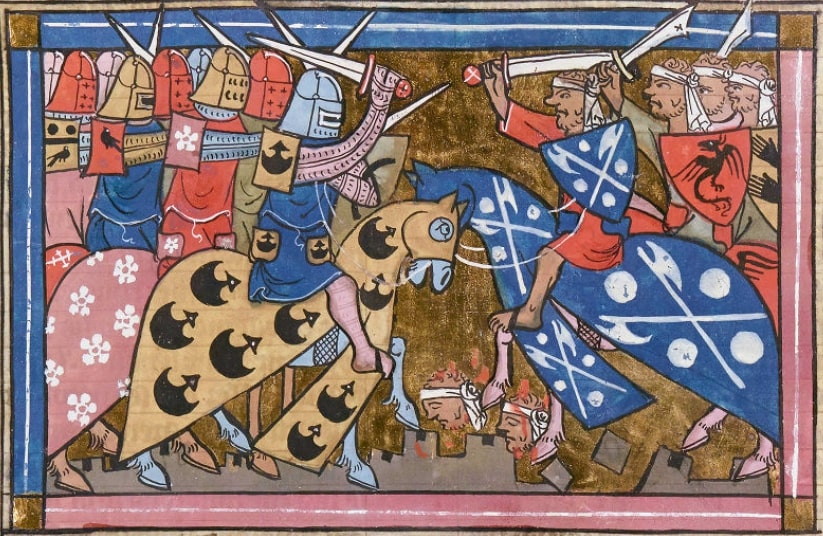|
Jean Colombe
Jean Colombe ( la, Ioannes Colombus; b. Bourges ca. 1430; d. ca. 1493) was a French miniature painter and illuminator of manuscripts. He is best known for his work in ''Très Riches Heures du Duc de Berry''. He was a son of Philippe Colombe and his wife Guillemette and thus the brother of the sculptor Michel Colombe. Work In 1470–1472, Colombe created the miniatures of the ''Heures de Louis de Laval''; around 1475, he illuminated the Crusades, crusader chronicles, ''Passages d'outremer, Les Passages d'oultre mer du noble Godefroy de Bouillon, du bon roy Saint Loys et de plusieurs vertueux princes'', by Sébastien Mamerot. Both works had been commissioned by Louis de Laval. Between 1485 and 1490, Jean Colombe completed the decoration of the ''Très Riches Heures'' which had been left unfinished in 1416. He executed the image for the month of November (below the zodiac arch), completed the Limbourg brothers’ design for September, and retouched other images. Further reading * ... [...More Info...] [...Related Items...] OR: [Wikipedia] [Google] [Baidu] |
Bourges
Bourges () is a commune in central France on the river Yèvre. It is the capital of the department of Cher, and also was the capital city of the former province of Berry. History The name of the commune derives either from the Bituriges, the name of the original inhabitants, or from the Germanic word '' Burg'' (French: ''bourg''; Spanish: ''burgo''; English, others: ''burgh'', '' berg'', or ''borough''), for "hill" or "village". The Celts called it ''Avaricon''; Latin-speakers: '' Avaricum''. In the fourth century BC, as in the time of Caesar, the area around it was the center of a Gallic (Celtic) confederacy. In 52 BC, the sixth year of the Gallic Wars, while the Gauls implemented a scorched-earth policy to try to deny Caesar's forces supplies, the inhabitants of Avaricum begged not to have their town burned. It was temporarily spared due to its good defences provided by the surrounding marshes, by a river that nearly encircled it, and by a strong southern wall. Juli ... [...More Info...] [...Related Items...] OR: [Wikipedia] [Google] [Baidu] |
Très Riches Heures Du Duc De Berry
The Très Riches Heures du Duc de Berry (; en, The Very Rich Hours of the Duke of Berry) or Très Riches Heures, is the most famous and possibly the best surviving example of Illuminated manuscript, manuscript illumination in the late phase of the International Gothic style. It is a book of hours: a collection of prayers to be said at the canonical hours. It was created between and 1416 for the extravagant royal bibliophile and patron John, Duke of Berry, by the Limbourg brothers.Manion 1996, p. 308. When the three painters and their sponsor died in 1416, possibly victims of Plague (disease), plague, the manuscript was left unfinished. It was further embellished in the 1440s by an anonymous painter, who many art historians believe was Barthélemy d'Eyck. In 1485–1489, it was brought to its present state by the painter Jean Colombe on behalf of the Duke of Savoy. Acquired by the Henri d'Orléans, Duke of Aumale, Duc d'Aumale in 1856, the book is now MS 65 in the Musée Co ... [...More Info...] [...Related Items...] OR: [Wikipedia] [Google] [Baidu] |
Michel Colombe
Michel Colombe (c. 1430 – c. 1513) was a French sculptor whose work bridged the late Gothic and Renaissance styles. Born in Bourges into a family of artisans, he was active in Tours. Colombe's surviving works all date from his old age. He created the ''gisant'' figures of the two deceased children of Charles VIII of France on their monument (1506) in Tours Cathedral. However, his most important surviving works were for the magnificent tomb of Francis II, Duke of Brittany, in Nantes Cathedral (1502–1507), and for the mausoleum of Philibert II of Savoy, at Notre-Dame de Brou, his masterwork. The Francis II monument was designed by Jean Perréal; it was disassembled and buried for safekeeping during the French Revolution. An ''Entombment'' at the Abbey of Solesmes (1494–1498) is attributed to him. A bas-relief commissioned in 1508 by Georges d'Amboise for the Château de Gaillon is conserved in the Musée du Louvre. His brother Jean Colombe was an important miniature pain ... [...More Info...] [...Related Items...] OR: [Wikipedia] [Google] [Baidu] |
Crusades
The Crusades were a series of religious wars initiated, supported, and sometimes directed by the Latin Church in the medieval period. The best known of these Crusades are those to the Holy Land in the period between 1095 and 1291 that were intended to recover Jerusalem and its surrounding area from Islamic rule. Beginning with the First Crusade, which resulted in the recovery of Jerusalem in 1099, dozens of Crusades were fought, providing a focal point of European history for centuries. In 1095, Pope Urban II proclaimed the First Crusade at the Council of Clermont. He encouraged military support for Byzantine emperor AlexiosI against the Seljuk Turks and called for an armed pilgrimage to Jerusalem. Across all social strata in western Europe, there was an enthusiastic response. The first Crusaders had a variety of motivations, including religious salvation, satisfying feudal obligations, opportunities for renown, and economic or political advantage. Later crusades were ... [...More Info...] [...Related Items...] OR: [Wikipedia] [Google] [Baidu] |
Passages D'outremer
The ''Passages d'outremer'' is a chronicle of the crusades written in Middle French by Sébastien Mamerot in 1473–1474. Drawing freely on legendary material, it covers the wars between Catholics and Muslims from the time of Charlemagne until 1462. Mamerot was the chaplain of Louis de Laval-Châtillon, governor of Genoa, who commissioned the ''Passages''. It is divided into 88 chapters and covers 272 folios in manuscript. Its full title is ''Passages fais oultre mer par les François contre les Turcqs et autres Sarrazins et Mores oultre marins'' ('Passages made overseas by the Franks against the Turks and other overseas Saracens and Moors'). The ''Passages d'outremer'' is conserved in three 15th-century manuscripts, all today in the Bibliothèque nationale de France (BnF), numbers fr. 5594, fr. 2626 and fr. 4769. A partial edition was printed at Paris by Michel Le Noir in 1518 under the title ''Les passaiges d'Oultremer faitz par les Françoys''. The manuscript BnF fr. 5594 is ... [...More Info...] [...Related Items...] OR: [Wikipedia] [Google] [Baidu] |
Sébastien Mamerot
Sébastien Mamerot (between and 1440 – 1490) was a French clergyman, scholar, novelist, and translator. Biography Originally from Soissons, Mamerot served as clergyman and secretary to Louis de Laval, governor of Dauphiné (1448–1458), Champagne (1465–1472) and Touraine (1483–1484), protégé and adviser to King Louis XI. In 1460, he became chaplain. From July 1472 to August 1478, he was a canon and cantor at the Collegiate Church of Saint-Étienne in Troyes. In 1466, he wrote '' Romuléon'', based on translating the original '' Romuleon'', a work commissioned by Louis de Laval. In 1472, Louis de Laval asked his clergyman and secretary, Mamerot, to write a chronicle of the Crusades. That work, entitled ''Passages d'outremer'', was a collection of various stories, from the legendary conquest of Jerusalem by Charlemagne to the Battle of Nicopolis in 1396 and Siege of Constantinople (1394–1402). Later on, another text was added to the beginning of the manuscript, a Fr ... [...More Info...] [...Related Items...] OR: [Wikipedia] [Google] [Baidu] |
Louis De Laval
Louis de Laval (1411 – 21 August 1489) was a French nobleman, soldier, politician and bibliophile. Life A member of the House of Laval, Louis was born in 1411. He was the third son of the Baroness Anne de Laval and Baron Guy XIII. He inherited the lordship of Châtillon-en-Vendelais in the barony of Vitré. He also acquired the castle of Comper and the . When his elder brothers, Count Guy XIV de Laval and André de Lohéac, joined Joan of Arc's campaign in 1429, Louis stayed home with their mother. In 1431, he was made captain of Jugon by Duke John V of Brittany. He later served Duke Peter II and the Constable Arthur de Richemont. According to , he was one of Richemont's squires at his second wedding to Jeanne II d'Albret in 1442. He was a permanent member of Richemont's company between 1443 and 1445. Afterwards, Louis sought advancement at the royal court. King Charles VII appointed him governor of the Dauphiné in 1448 and of French-occupied Genoa in 1461. He was in G ... [...More Info...] [...Related Items...] OR: [Wikipedia] [Google] [Baidu] |
Zodiac
The zodiac is a belt-shaped region of the sky that extends approximately 8° north or south (as measured in celestial latitude) of the ecliptic, the apparent path of the Sun across the celestial sphere over the course of the year. The paths of the Moon and visible planets are within the belt of the zodiac. In Western astrology, and formerly astronomy, the zodiac is divided into twelve signs, each occupying 30° of celestial longitude and roughly corresponding to the following star constellations: Aries, Taurus, Gemini, Cancer, Leo, Virgo, Libra, Scorpio, Sagittarius, Capricorn, Aquarius, and Pisces. These astrological signs form a celestial coordinate system, or more specifically an ecliptic coordinate system, which takes the ecliptic as the origin of latitude and the Sun's position at vernal equinox as the origin of longitude. Name The English word ' derives from , the Latinized form of the Ancient Greek ( ), meaning "cycle or circle of little anim ... [...More Info...] [...Related Items...] OR: [Wikipedia] [Google] [Baidu] |
Limbourg Brothers
The Limbourg brothers ( nl, Gebroeders van Limburg or Gebroeders Van Lymborch; fl. 1385 – 1416) were famous Dutch miniature (illuminated manuscript), miniature painters (Herman, Paul, and Johan) from the city of Nijmegen. They were active in the early 15th century in France and Duchy of Burgundy, Burgundy, working in the style known as International Gothic. They created what is certainly the best-known late medieval illuminated manuscript, the ''Très Riches Heures du Duc de Berry''. Uncle Malouel Around 1398, after their father's death, the brothers were sent for by their uncle Jean Malouel (or Johan Maelwael, ''Jehan Maleuel'' in original French sources), the most important painter for the French and Burgundian courts of the time. Herman and Johan learned the craft of goldsmithing in Paris. At the end of 1399 they were travelling to visit Nijmegen but, owing to a war, they were captured in Brussels. Since their mother could not pay the ransom of 55 gold ''escuz'', th ... [...More Info...] [...Related Items...] OR: [Wikipedia] [Google] [Baidu] |
1430 Births
143 may refer to: *143 (number), a natural number *AD 143, a year of the 2nd century AD *143 BC, a year of the 2nd century BC * ''143'' (EP), a 2013 EP by Tiffany Evans * ''143'' (album), a 2015 album by Bars and Melody * ''143'' (2004 film), a 2004 Indian Telugu film * ''143'' (2022 film), a 2022 Indian Marathi film *''143'', a song by Set It Off from their 2009 EP, ''Calm Before the Storm'' *"1-4-3 (I Love You)", a 2013 song by Henry Lau *143 (West Midlands) Brigade *143 Records, record label of producer David Foster * KiYa 143 The is a four-axle B-B wheel arrangement diesel-hydraulic locomotive type operated in Japan since 2014 by West Japan Railway Company (JR West). Operations The KiYa 143 locomotives are used as self-propelled snowplough units during the wint ..., a locomotive type See also * List of highways numbered 143 * {{numberdis ... [...More Info...] [...Related Items...] OR: [Wikipedia] [Google] [Baidu] |






